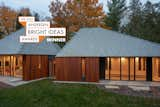This Multigenerational Retreat in Wisconsin Spans Three Interconnected Pavilions
Partner Story

On the western shore of Lake Michigan in Door County, Wisconsin, undulating sand dunes and dense vegetation create the idyllic context that drew one multigenerational family together to build a communal second home. The three generations—scattered all over the country—wanted a centralized place to come together as a family where they could unwind and disconnect from their hectic urban lives.
To design the multipurpose, multigenerational retreat, the family engaged Milwaukee- and Boston-based architecture firm LA DALLMAN. "The family was quite interested in living in a shared space that is also very connected to the surrounding landscape," shares LA DALLMAN principal James T. Dallman. "[They have] had many years to get to know the nuanced qualities of this place, and their deep knowledge, built up over generations, was central to the design process."
To accommodate a variety of different family activities, the home was pulled apart into three distinct pavilions—designed to live, play, and rest. The "live" pavilion contains the home’s kitchen and an open living room; the "play" pavilion contains a large multi-purpose space, a study loft, and a mudroom; and the "rest" pavilion includes two traditional bedrooms, plus a bunk room for children and guests—with each of the three volumes connected by a central hall. "Though we were excited by the idea of articulating the three pavilion volumes as distinct entities, it was also important to us that they never feel entirely separate," says Dallman.
Although LA DALLMAN’s initial design approach was to create low-lying volumes that would "hug" the ground plane, input from the family changed the trajectory of the home’s form. "The client felt that the building's presence should be more in keeping with the simple cottage structures that surround it, and embrace some of that ethos of simplicity and modesty," Dallman says. "This forced us, in the best possible way, to modify our preliminary design impulses." Turning their focus to the barns, schoolhouses, sheds, and granaries which dominated the agrarian landscape, the LA DALLMAN team began to consider volume, pitched roofs, and overhangs in a way they hadn’t before.
Instead of lean, low-slung volumes hugging the earth, Dallman and team modified their initial concept to embrace Door County’s "cottage culture." Subsequent design iterations took the previously flat form to new heights—using ceiling trusses to accentuate volume and modernize the typology of a simple cottage.
Maintaining a strong connection to the landscape—with its mixed deciduous and coniferous forest—was a fundamental objective of the home’s design. "It was important to maximize exposure to the surrounding forest, while controlling views to (and from) the road and the adjacent neighbors, and optimizing interior daylight," shares Dallman. "This required a variety of aperture types." Perhaps the most striking of these apertures are the oculi which grace the highest point of each pitched roof. These de-centered apertures create a visually striking geometry and help unify the three separate structures. "One of the most important geometric moves is to bring the apex of each pavilion volume in towards the center of the composition, so that one always feels that the parts of the house are intrinsically interrelated, leaning in towards each other," says Dallman.
In the Pavilion House, over 150 wood trusses were integrated to create soaring, cathedral-like ceilings—a distinct departure from the construction of a conventional hipped roof. In a typical barn structure, for example, rafters are held together by collar ties, which, importantly, counteract the outward force of the roof—but also restrict ceiling height in the process. "Unimpeded by collar ties, and rising freely to meet the oculi, the ceilings can function as light scoops and ventilation devices, while maximizing the interior volumes," says Dallman of the structurally-pivotal ceiling trusses.
The success of the Pavilion House is perhaps best measured in the nuanced experience of family members and guests who spend time at the property. "A common refrain is that it somehow captures the spirit of the place—open, relaxed, warm, beachy, nestled in the forest—while managing at the same time to feel unexpected, surprising," reflects Dallman. "I think that everyone who has spent time there has shared their love of the way it connects to the site and makes them feel at home."
Learn more about all the 2024 honorees and the judging process at andersenawards.dwell.com.
Read about the other honorees:
In Portland, Maine, 23 Residential Apartments Rise on a City-Owned Parking Lot
A New York Family Builds an Unexpected Seaside Retreat in the Hamptons
A Minnesota Home Is Carefully Inserted Into the Gently Rolling Hillside
Published
Get the Pro Newsletter
What’s new in the design world? Stay up to date with our essential dispatches for design professionals.










